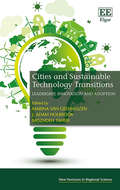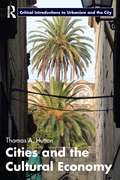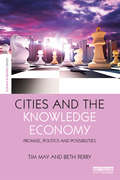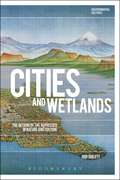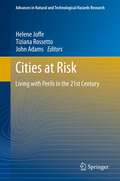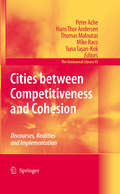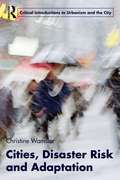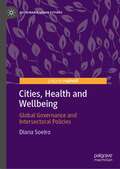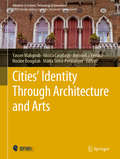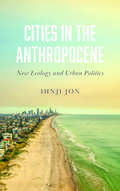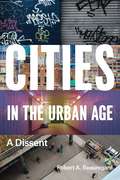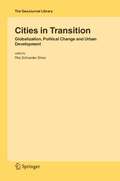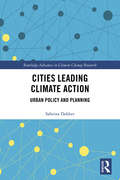- Table View
- List View
Cities and Sustainable Technology Transitions: Leadership, Innovation and Adoption (New Horizons in Regional Science series)
by Marina Van Geenhuizen J. Adam Holbrook Mozhdeh TaheriCities are undoubted key players in technology creation and adoption for sustainable transitions. This book addresses both the active and passive roles of cities in technology innovation, commercialisation, mass-production and adoption. In particular, it examines elements of three socio-technical systems, energy, transport and healthcare. The authors investigate cities in Europe, Asia and North America, providing an in depth understanding of the differences in leadership roles that cities adopt across the globe. The book breaks new ground in the analysis of topical issues such as local ‘cradle’ conditions, incentive schemes, niche-development, living labs, impact bonds, grass-roots intermediation and adaptive policy making. Researchers and students involved in the urban studies, socio-technical transitions and sustainability would greatly benefit from reading this book. The variety of practical examples also makes this book an important tool for city policy makers, as well as public policy and public sector scholars.
Cities and the Cultural Economy (Routledge Critical Introductions to Urbanism and the City)
by Thomas A. HuttonThe cultural economy forms a leading trajectory of urban development, and has emerged as a key facet of globalizing cities. Cultural industries include new media, digital arts, music and film, and the design industries and professions, as well as allied consumption and spectacle in the city. The cultural economy now represents the third-largest sector in many metropolitan cities of the West including London, Berlin, New York, San Francisco, and Melbourne, and is increasingly influential in the development of East Asian cities (Tokyo, Shanghai, Hong Kong and Singapore), as well as the mega-cities of the Global South (e.g. Mumbai, Capetown, and São Paulo). Cities and the Cultural Economy provides a critical integration of the burgeoning research and policy literatures in one of the most prominent sub-fields of contemporary urban studies. Policies for cultural economy are increasingly evident within planning, development and place-marketing programs, requiring large resource commitments, but producing – on the evidence – highly uneven results. Accordingly the volume includes a critical review of how the new cultural economy is reshaping urban labour, housing and property markets, contributing to gentrification and to ‘precarious employment’ formation, as well as to broadly favorable outcomes, such as community regeneration and urban vitality. The volume acknowledges the important growth dynamics and sustainability of key creative industries. Written primarily as a text for upper-level undergraduate and Masters students in urban, economic and social geography; sociology; cultural studies; and planning, this provocative and compelling text will also be of interest to those studying urban land economics, architecture, landscape architecture and the built environment.
Cities and the Cultural Economy (Routledge Critical Introductions to Urbanism and the City)
by Thomas A. HuttonThe cultural economy forms a leading trajectory of urban development, and has emerged as a key facet of globalizing cities. Cultural industries include new media, digital arts, music and film, and the design industries and professions, as well as allied consumption and spectacle in the city. The cultural economy now represents the third-largest sector in many metropolitan cities of the West including London, Berlin, New York, San Francisco, and Melbourne, and is increasingly influential in the development of East Asian cities (Tokyo, Shanghai, Hong Kong and Singapore), as well as the mega-cities of the Global South (e.g. Mumbai, Capetown, and São Paulo). Cities and the Cultural Economy provides a critical integration of the burgeoning research and policy literatures in one of the most prominent sub-fields of contemporary urban studies. Policies for cultural economy are increasingly evident within planning, development and place-marketing programs, requiring large resource commitments, but producing – on the evidence – highly uneven results. Accordingly the volume includes a critical review of how the new cultural economy is reshaping urban labour, housing and property markets, contributing to gentrification and to ‘precarious employment’ formation, as well as to broadly favorable outcomes, such as community regeneration and urban vitality. The volume acknowledges the important growth dynamics and sustainability of key creative industries. Written primarily as a text for upper-level undergraduate and Masters students in urban, economic and social geography; sociology; cultural studies; and planning, this provocative and compelling text will also be of interest to those studying urban land economics, architecture, landscape architecture and the built environment.
Cities and the Knowledge Economy: Promise, Politics and Possibilities (The Earthscan Science in Society Series)
by Tim May Beth PerryCities and the Knowledge Economy is an in-depth, interdisciplinary, international and comparative examination of the relationship between knowledge and urban development in the contemporary era. Through the lenses of promise, politics and possibility, it examines how the knowledge economy has arisen, how different cities have sought to realise its potential, how universities play a role in its realisation and, overall, what this reveals about the relationship between politics, capitalism, space, place and knowledge in cities. The book argues that the 21st century city has been predicated on particular circuits of knowledge that constitute expertise as residing in elite and professional epistemic communities. In contrast, alternative conceptions of the knowledge society are founded on assumptions which take analysis, deliberation, democracy and the role of the citizen and communities of practice seriously. Drawing on a range of examples from cities around the world, the book reflects on these possibilities and asks what roles the practice of ‘active intermediation’, the university and a critical and engaged social scientific practice can all play in this process. The book is aimed at researchers and students from different disciplines – geography, politics, sociology, business studies, economics and planning – with interests in contemporary urbanism and the role of knowledge in understanding development, as well as urban policymakers, politicians and practitioners who are concerned with the future of our cities and seek to create coalitions of different communities oriented towards more just and sustainable futures.
Cities and the Knowledge Economy: Promise, Politics and Possibilities (The Earthscan Science in Society Series)
by Tim May Beth PerryCities and the Knowledge Economy is an in-depth, interdisciplinary, international and comparative examination of the relationship between knowledge and urban development in the contemporary era. Through the lenses of promise, politics and possibility, it examines how the knowledge economy has arisen, how different cities have sought to realise its potential, how universities play a role in its realisation and, overall, what this reveals about the relationship between politics, capitalism, space, place and knowledge in cities. The book argues that the 21st century city has been predicated on particular circuits of knowledge that constitute expertise as residing in elite and professional epistemic communities. In contrast, alternative conceptions of the knowledge society are founded on assumptions which take analysis, deliberation, democracy and the role of the citizen and communities of practice seriously. Drawing on a range of examples from cities around the world, the book reflects on these possibilities and asks what roles the practice of ‘active intermediation’, the university and a critical and engaged social scientific practice can all play in this process. The book is aimed at researchers and students from different disciplines – geography, politics, sociology, business studies, economics and planning – with interests in contemporary urbanism and the role of knowledge in understanding development, as well as urban policymakers, politicians and practitioners who are concerned with the future of our cities and seek to create coalitions of different communities oriented towards more just and sustainable futures.
Cities and Wetlands: The Return of the Repressed in Nature and Culture (Environmental Cultures)
by Rod GiblettFrom New Orleans to New York, from London to Paris to Venice, many of the world's great cities were built on wetlands and swamps. Cities and Wetlands is the first book to explore the literary and cultural histories of these cities and their relationships to their environments and buried histories. Developing a ground-breaking new mode of psychoanalytic ecology and surveying a wide range of major cities in North America and Europe, ecocritic and activist Rod Giblett shows how the wetland origins of these cities haunt their later literature and culture and might prompt us to reconsider the relationship between human culture and the environment.Cities covered include: Berlin, Boston, Chicago, Hamburg, London, New Orleans, New York, Paris, St. Petersburg, Toronto, Venice and Washington.
Cities at Risk: Living with Perils in the 21st Century (Advances in Natural and Technological Hazards Research #33)
by Helene Joffe, Tiziana Rossetto and John AdamsWith the major growth of the world’s population over the past century, as well as rapid urbanisation, people increasingly live in crowded cities. This trend is often accompanied by proliferation of poorly built housing, uncontrolled use of land, occupation of unsafe environments and overstretched services. When a natural hazard strikes such a city many people are vulnerable to loss of life and property. This book explores what these people think and feel about the threats that they face. How do they live with perils ranging from earthquakes to monsoons, from floods to hurricanes, in the 21st century?The authors are drawn from a large range of disciplines: Psychology, Engineering, Geography, Anthropology and Urban Planning. They also reflect on how perils are represented in multiple cultures: the United States, Japan, Turkey, Bangladesh, the United Kingdom and New Zealand. The book therefore not only brings to light the ways that different cultures represent natural hazards but also the different ways in which various disciplines write about living with perils in the 21st century.The book is addressed both to researchers and to organizations involved with risk management and risk mitigation.
Cities between Competitiveness and Cohesion: Discourses, Realities and Implementation (GeoJournal Library #93)
by Peter Ache Tuna Ta 351 An-Kok Hans Thor Andersen Thomas Maloutas Mike RacoThis book offers a cross-European analysis of urban and regional strategies of reconciling welfare and competitiveness. It develops an understanding of the strategy challenge to reconcile competitiveness with cohesion, and provides an analysis of cities and regions as actors in multi-level governance settings. The book offers a European comparative view on housing, labour markets, enterprises, ethnical issues, gender dimensions, urban development projects, transport, and sustainability.
Cities, Disaster Risk and Adaptation
by Christine WamslerWorldwide, disasters and climate change pose a serious risk to sustainable urban development, resulting in escalating human and economic costs. Consequently, city authorities and other urban actors face the challenge of integrating risk reduction and adaptation strategies into their work. However, related knowledge and expertise are still scarce and fragmented. Cities, Disaster Risk and Adaptation explores ways in which resilient cities can be ‘built’ and sustainable urban transformations achieved. The book provides a comprehensive understanding of urban risk reduction and adaptation planning, exploring key theoretical concepts and analysing the complex interrelations between cities, disasters and climate change. Furthermore, it provides an overview of current risk reduction and adaptation approaches taken by both city authorities and city dwellers from diverse contexts in low, middle and high income nations. Finally, the book offers a planning framework for reducing and adapting to risk in urban areas by expanding on pre-existing positive actions and addressing current shortfalls in theory and practice. The importance of a distributed urban governance system, in which institutions’ and citizens’ adaptive capacities can support and complement each other, is highlighted. This book takes a holistic approach; it integrates perspectives and practice from risk reduction and climate change adaptation based on a specific urban viewpoint. The text is richly supplemented with boxed case studies written by renowned academics and practitioners in the field and ‘test yourself’ scenarios that integrate theory into practice. Each chapter contains learning objectives, end of chapter questions, suggested further reading and web resources, as well as a wealth of tables and figures. This book is essential reading for undergraduate and postgraduate students of geography, urban studies and planning, architecture, environmental studies, international development, sociology and sustainability studies.
Cities, Disaster Risk and Adaptation
by Christine WamslerWorldwide, disasters and climate change pose a serious risk to sustainable urban development, resulting in escalating human and economic costs. Consequently, city authorities and other urban actors face the challenge of integrating risk reduction and adaptation strategies into their work. However, related knowledge and expertise are still scarce and fragmented. Cities, Disaster Risk and Adaptation explores ways in which resilient cities can be ‘built’ and sustainable urban transformations achieved. The book provides a comprehensive understanding of urban risk reduction and adaptation planning, exploring key theoretical concepts and analysing the complex interrelations between cities, disasters and climate change. Furthermore, it provides an overview of current risk reduction and adaptation approaches taken by both city authorities and city dwellers from diverse contexts in low, middle and high income nations. Finally, the book offers a planning framework for reducing and adapting to risk in urban areas by expanding on pre-existing positive actions and addressing current shortfalls in theory and practice. The importance of a distributed urban governance system, in which institutions’ and citizens’ adaptive capacities can support and complement each other, is highlighted. This book takes a holistic approach; it integrates perspectives and practice from risk reduction and climate change adaptation based on a specific urban viewpoint. The text is richly supplemented with boxed case studies written by renowned academics and practitioners in the field and ‘test yourself’ scenarios that integrate theory into practice. Each chapter contains learning objectives, end of chapter questions, suggested further reading and web resources, as well as a wealth of tables and figures. This book is essential reading for undergraduate and postgraduate students of geography, urban studies and planning, architecture, environmental studies, international development, sociology and sustainability studies.
Cities, Health and Wellbeing: Global Governance and Intersectoral Policies (Sustainable Urban Futures)
by Diana SoeiroOn 25 September 2015, the United Nations General Assembly unanimously adopted Resolution 70/1, “Transforming our World: the 2030 Agenda for Sustainable Development”. Also known as 2030 Agenda, the document lays out 17 Sustainable Development Goals (SDGs) in the realm of ecology, society and economy. The current book focuses on three of these goals: SDG 16: Peace, Justice and Strong Institutions; SDG 3: Health and Wellbeing; SDG 11: Cities and Sustainable Communities. It is critical that interdisciplinary approaches go one step further and translate more effectively into intersectoral policies. This is particularly vital when it comes to urban planning and health. This book address the key question: In the context of a growing influence of European Union policies at a national level, can SDGs simultaneously contribute to harmonising sectoral policies and promoting intersectoral policies? Claiming a growing convergence between health and spatial planning, the main goal of the book is to formulate an answer to the following question: how can policymakers translate the SDGs effectively into public policies in order to improve cities, health and wellbeing?
Cities' Identity Through Architecture and Arts: Proceedings Of The International Conference On Cities' Identity Through Architecture And Arts (citaa 2017), May 11-13, 2017, Cairo, Egypt (Advances in Science, Technology & Innovation)
by Yasser Mahgoub Nicola Cavalagli Antonella Versaci Hocine Bougdah Marta Serra-PermanyerThis book covers a broad range of topics relating to architecture and urban design, such as the conservation of cities’ culture and identity through design and planning processes, various ideologies and approaches to achieving more sustainable cities while retaining their identities, and strategies to help cities advertise themselves on the global market.Every city has its own unique identity, which is revealed through its physical and visual form. It is seen through the eyes of its inhabitants and visitors, and is where their collective memories are shaped. In turn, these factors affect tourism, education, culture & economic prosperity, in addition to other aspects, making a city’s identity one of its main assets.Cities’ identities are constructed and developed over time and are constantly evolving physically, culturally and sociologically. This book explains how architecture and the arts can embody the historical, cultural and economic characteristics of the city. It also demonstrates how cities’ memories play a vital role in preserving their physical and nonphysical heritage. Furthermore, it examines the transformation of cities and urban cultures, and investigates the various new approaches developed in contemporary arts and architecture.Given its scope, the book is a valuable resource for a variety of readers, including students, educators, researchers and practitioners in the fields of city planning, urban design, architecture and the arts.
Cities in Crisis: Socio-spatial impacts of the economic crisis in Southern European cities (Regions and Cities)
by Jörg Knieling Frank OthengrafenIn recent years, European societies and territories have witnessed the spatial impacts of a severe financial and socio-economic crisis. This book builds on the current debate concerning how cities and urban regions and their citizens deal with the consequences of the recent financial and socio-economic crisis. Cities in Crisis examines the political and administrative implications of austerity measures applied in southern European cities. These include cuts in local public spending and the processes of privatization of local public assets, as well as issues related to the re-scaling, recentralization or decentralization of competencies. Attention is paid to the rise of new ‘austerity regimes’, the question of their legitimacy and their spatial manifestations, and in particular to the social consequences of austerity. The contributions to this book lay the foundation for recommendations on how to improve and consolidate qualified governance arrangements in order to better address rapid economic and social changes. Such recommendations are applicable to cities and urban regions both within and outside of Europe. It identifies possible approaches, tools and partnerships to tackle the effects of the crisis and to prepare European cities for future challenges.
Cities in Crisis: Socio-spatial impacts of the economic crisis in Southern European cities (Regions and Cities)
by Jörg Knieling Frank OthengrafenIn recent years, European societies and territories have witnessed the spatial impacts of a severe financial and socio-economic crisis. This book builds on the current debate concerning how cities and urban regions and their citizens deal with the consequences of the recent financial and socio-economic crisis. Cities in Crisis examines the political and administrative implications of austerity measures applied in southern European cities. These include cuts in local public spending and the processes of privatization of local public assets, as well as issues related to the re-scaling, recentralization or decentralization of competencies. Attention is paid to the rise of new ‘austerity regimes’, the question of their legitimacy and their spatial manifestations, and in particular to the social consequences of austerity. The contributions to this book lay the foundation for recommendations on how to improve and consolidate qualified governance arrangements in order to better address rapid economic and social changes. Such recommendations are applicable to cities and urban regions both within and outside of Europe. It identifies possible approaches, tools and partnerships to tackle the effects of the crisis and to prepare European cities for future challenges.
Cities in the Anthropocene: New Ecology and Urban Politics
by Ihnji JonClimate change is real, and extreme weather events are its physical manifestations. These extreme events affect how we live and work in cities, and subsequently the way we design, plan, and govern them. Taking action 'for the environment' is not only a moral imperative; instead, it is activated by our everyday experience in the city. Based on the author's site visits and interviews in Darwin (Australia), Tulsa (Oklahoma), Cleveland (Ohio), and Cape Town (South Africa), this book tells the story of how cities can lead a transformative pro-environment politics. National governments often fail to make binding agreements that bring about radical actions for the environment. This book shows how cities, as local sites of mobilizing a collective, political agenda, can be frontiers for activating the kind of environmental politics that appreciates the role of 'nature' in the everyday functioning of our urban life.
Cities in the Anthropocene: New Ecology and Urban Politics
by Ihnji JonClimate change is real, and extreme weather events are its physical manifestations. These extreme events affect how we live and work in cities, and subsequently the way we design, plan, and govern them. Taking action 'for the environment' is not only a moral imperative; instead, it is activated by our everyday experience in the city. Based on the author's site visits and interviews in Darwin (Australia), Tulsa (Oklahoma), Cleveland (Ohio), and Cape Town (South Africa), this book tells the story of how cities can lead a transformative pro-environment politics. National governments often fail to make binding agreements that bring about radical actions for the environment. This book shows how cities, as local sites of mobilizing a collective, political agenda, can be frontiers for activating the kind of environmental politics that appreciates the role of 'nature' in the everyday functioning of our urban life.
Cities in the Urban Age: A Dissent
by Robert A. BeauregardWe live in a self-proclaimed Urban Age, where we celebrate the city as the source of economic prosperity, a nurturer of social and cultural diversity, and a place primed for democracy. We proclaim the city as the fertile ground from which progress will arise. Without cities, we tell ourselves, human civilization would falter and decay. In Cities in the Urban Age, Robert A. Beauregard argues that this line of thinking is not only hyperbolic—it is too celebratory by half. For Beauregard, the city is a cauldron for four haunting contradictions. First, cities are equally defined by both their wealth and their poverty. Second, cities are simultaneously environmentally destructive and yet promise sustainability. Third, cities encourage rule by political machines and oligarchies, even as they are essentially democratic and at least nominally open to all. And fourth, city life promotes tolerance among disparate groups, even as the friction among them often erupts into violence. Beauregard offers no simple solutions or proposed remedies for these contradictions; indeed, he doesn’t necessarily hold that they need to be resolved, since they are generative of city life. Without these four tensions, cities wouldn’t be cities. Rather, Beauregard argues that only by recognizing these ambiguities and contradictions can we even begin to understand our moral obligations, as well as the clearest paths toward equality, justice, and peace in urban settings.
Cities in the Urban Age: A Dissent
by Robert A. BeauregardWe live in a self-proclaimed Urban Age, where we celebrate the city as the source of economic prosperity, a nurturer of social and cultural diversity, and a place primed for democracy. We proclaim the city as the fertile ground from which progress will arise. Without cities, we tell ourselves, human civilization would falter and decay. In Cities in the Urban Age, Robert A. Beauregard argues that this line of thinking is not only hyperbolic—it is too celebratory by half. For Beauregard, the city is a cauldron for four haunting contradictions. First, cities are equally defined by both their wealth and their poverty. Second, cities are simultaneously environmentally destructive and yet promise sustainability. Third, cities encourage rule by political machines and oligarchies, even as they are essentially democratic and at least nominally open to all. And fourth, city life promotes tolerance among disparate groups, even as the friction among them often erupts into violence. Beauregard offers no simple solutions or proposed remedies for these contradictions; indeed, he doesn’t necessarily hold that they need to be resolved, since they are generative of city life. Without these four tensions, cities wouldn’t be cities. Rather, Beauregard argues that only by recognizing these ambiguities and contradictions can we even begin to understand our moral obligations, as well as the clearest paths toward equality, justice, and peace in urban settings.
Cities in the Urban Age: A Dissent
by Robert A. BeauregardWe live in a self-proclaimed Urban Age, where we celebrate the city as the source of economic prosperity, a nurturer of social and cultural diversity, and a place primed for democracy. We proclaim the city as the fertile ground from which progress will arise. Without cities, we tell ourselves, human civilization would falter and decay. In Cities in the Urban Age, Robert A. Beauregard argues that this line of thinking is not only hyperbolic—it is too celebratory by half. For Beauregard, the city is a cauldron for four haunting contradictions. First, cities are equally defined by both their wealth and their poverty. Second, cities are simultaneously environmentally destructive and yet promise sustainability. Third, cities encourage rule by political machines and oligarchies, even as they are essentially democratic and at least nominally open to all. And fourth, city life promotes tolerance among disparate groups, even as the friction among them often erupts into violence. Beauregard offers no simple solutions or proposed remedies for these contradictions; indeed, he doesn’t necessarily hold that they need to be resolved, since they are generative of city life. Without these four tensions, cities wouldn’t be cities. Rather, Beauregard argues that only by recognizing these ambiguities and contradictions can we even begin to understand our moral obligations, as well as the clearest paths toward equality, justice, and peace in urban settings.
Cities in the Urban Age: A Dissent
by Robert A. BeauregardWe live in a self-proclaimed Urban Age, where we celebrate the city as the source of economic prosperity, a nurturer of social and cultural diversity, and a place primed for democracy. We proclaim the city as the fertile ground from which progress will arise. Without cities, we tell ourselves, human civilization would falter and decay. In Cities in the Urban Age, Robert A. Beauregard argues that this line of thinking is not only hyperbolic—it is too celebratory by half. For Beauregard, the city is a cauldron for four haunting contradictions. First, cities are equally defined by both their wealth and their poverty. Second, cities are simultaneously environmentally destructive and yet promise sustainability. Third, cities encourage rule by political machines and oligarchies, even as they are essentially democratic and at least nominally open to all. And fourth, city life promotes tolerance among disparate groups, even as the friction among them often erupts into violence. Beauregard offers no simple solutions or proposed remedies for these contradictions; indeed, he doesn’t necessarily hold that they need to be resolved, since they are generative of city life. Without these four tensions, cities wouldn’t be cities. Rather, Beauregard argues that only by recognizing these ambiguities and contradictions can we even begin to understand our moral obligations, as well as the clearest paths toward equality, justice, and peace in urban settings.
Cities in the Urban Age: A Dissent
by Robert A. BeauregardWe live in a self-proclaimed Urban Age, where we celebrate the city as the source of economic prosperity, a nurturer of social and cultural diversity, and a place primed for democracy. We proclaim the city as the fertile ground from which progress will arise. Without cities, we tell ourselves, human civilization would falter and decay. In Cities in the Urban Age, Robert A. Beauregard argues that this line of thinking is not only hyperbolic—it is too celebratory by half. For Beauregard, the city is a cauldron for four haunting contradictions. First, cities are equally defined by both their wealth and their poverty. Second, cities are simultaneously environmentally destructive and yet promise sustainability. Third, cities encourage rule by political machines and oligarchies, even as they are essentially democratic and at least nominally open to all. And fourth, city life promotes tolerance among disparate groups, even as the friction among them often erupts into violence. Beauregard offers no simple solutions or proposed remedies for these contradictions; indeed, he doesn’t necessarily hold that they need to be resolved, since they are generative of city life. Without these four tensions, cities wouldn’t be cities. Rather, Beauregard argues that only by recognizing these ambiguities and contradictions can we even begin to understand our moral obligations, as well as the clearest paths toward equality, justice, and peace in urban settings.
Cities in the Urban Age: A Dissent
by Robert A. BeauregardWe live in a self-proclaimed Urban Age, where we celebrate the city as the source of economic prosperity, a nurturer of social and cultural diversity, and a place primed for democracy. We proclaim the city as the fertile ground from which progress will arise. Without cities, we tell ourselves, human civilization would falter and decay. In Cities in the Urban Age, Robert A. Beauregard argues that this line of thinking is not only hyperbolic—it is too celebratory by half. For Beauregard, the city is a cauldron for four haunting contradictions. First, cities are equally defined by both their wealth and their poverty. Second, cities are simultaneously environmentally destructive and yet promise sustainability. Third, cities encourage rule by political machines and oligarchies, even as they are essentially democratic and at least nominally open to all. And fourth, city life promotes tolerance among disparate groups, even as the friction among them often erupts into violence. Beauregard offers no simple solutions or proposed remedies for these contradictions; indeed, he doesn’t necessarily hold that they need to be resolved, since they are generative of city life. Without these four tensions, cities wouldn’t be cities. Rather, Beauregard argues that only by recognizing these ambiguities and contradictions can we even begin to understand our moral obligations, as well as the clearest paths toward equality, justice, and peace in urban settings.
Cities in Transition: Globalization, Political Change and Urban Development (GeoJournal Library #83)
by Rita Schneider-SliwaThis book was written with the aim of showing that even in the era of globalization developments appearing in cities are not subject to almost unconditional global forces. Rather, universal forces are decisive eventualities in the process of urban restructuring, often influencing its course and speed, yet developments and particularities within a city strongly influence the course of events and the extent to which negative characteristics of globalization might occur. Berlin, Brussels, Hanoi, Ho Chi Minh City, Hong Kong, Jerusalem, Johannesburg, Moscow, St. Petersburg, Sarajevo and Vienna: Using these important cities the special relationship between global and local/regional forces is analyzed. The case studies were selected based on their political and cultural context and the fact that their social and political fabric was subject to major changes in the recent past. How global processes manifest themselves locally depends to a great extent on how development processes and endogenic potentials are initiated locally in order to cope with the new global economic and societal conditions.
Cities Leading Climate Action: Urban Policy and Planning (Routledge Advances in Climate Change Research)
by Sabrina DekkerThis book provides local governments and interested stakeholders with insights into the challenges and opportunities inherent in addressing climate change. Drawing on in-depth case study research on Vancouver, Portland, Glasgow and Dublin, Dekker examines the policy development processes employed by urban policy makers to respond to climate change, looking specifically at the utilisation of collaborative planning. Emerging from the case studies are lessons for local governments in relation to the role of organisational structure in supporting climate leadership; the importance of leadership, trust, relationship building and narratives for supporting ownership of the responses to climate change by stakeholders; and the need for creative and innovative public engagement to expand the reach of traditional methods such as social media and other technology-based solutions. Finally, Dekker reflects on her experience in the development of climate change action plans for the Dublin Local Authorities. This book will be of great relevance to students, scholars and policy makers with an interest in climate change resilience, environmental policy and urban planning.
Cities Leading Climate Action: Urban Policy and Planning (Routledge Advances in Climate Change Research)
by Sabrina DekkerThis book provides local governments and interested stakeholders with insights into the challenges and opportunities inherent in addressing climate change. Drawing on in-depth case study research on Vancouver, Portland, Glasgow and Dublin, Dekker examines the policy development processes employed by urban policy makers to respond to climate change, looking specifically at the utilisation of collaborative planning. Emerging from the case studies are lessons for local governments in relation to the role of organisational structure in supporting climate leadership; the importance of leadership, trust, relationship building and narratives for supporting ownership of the responses to climate change by stakeholders; and the need for creative and innovative public engagement to expand the reach of traditional methods such as social media and other technology-based solutions. Finally, Dekker reflects on her experience in the development of climate change action plans for the Dublin Local Authorities. This book will be of great relevance to students, scholars and policy makers with an interest in climate change resilience, environmental policy and urban planning.
